Vietnam: The Helicopter War
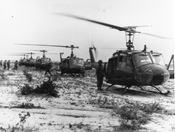
1969 - 1st Brigade 101st Airborne Division - Fire Base Saber
U.S. Army Aviation Museum Volunteer Archivists Collection [va058394]
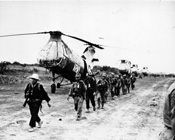
Large conventional-type forces can be quickly deployed by helicopter to overcome concentrated, guerilla rear guard action. 8th Transportation Company. - 1962. Use of Army ARVN in counterinsurgency. - Stabilizers have been removed forming a combat mission
U.S. Army Aviation Museum Volunteer Archivists Collection [va058495]
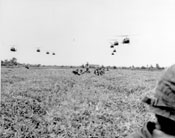
UH-1D helicopters - Troops wait to be picked up after a day in the field. Location: Saigon, Vietnam. Photographer: Raymond Shultz
U.S. Army Aviation Museum Volunteer Archivists Collection [va058767]
Becoming "Airmobile"
- "[The guys on the ground] loved us because we were able to look out where they couldn't see and we were able to cover them when they were moving and were able to shoot from the sky and we were a lot closer than the jets were. Although the jets had napalm and snake eye and all those great things, we were more capable of getting down and dirty and closer to them and doing things on the spot that they needed done."
- John Arick, from Interview with John Arick [OH0268]
Growing increasingly concerned about the situation in Vietnam in the early 1960s, President John F. Kennedy expanded the U.S. military advisory effort in support of the Republic of Vietnam (RVN) from 1,000 advisors in 1961 to more than 16,000 by the time of his assassination in November 1963. As the number of U.S. advisors grew, they also focused on training the South Vietnamese Army (ARVN) to use U.S. military tactics and equipment. Although the U.S. Army had already dedicated units to the notion of an "Airmobile" force, the blending of tactics and technology remained largely at a theoretical level until 1962. The war in Vietnam provided the perfect testing ground for these new ideas, giving rise to the military concept of "Airmobility" that would come to dominate the Vietnam War.
The first significant use of helicopters in support of combat in Vietnam occurred during the battle of Ap Bac in early January of 1963. A well-trained ARVN force of about 1,500 men supported by helicopters went up against a vastly smaller and lesser-equipped Viet Cong force of about 350 men. Although the Viet Cong did flee the battlefield after a single day of fighting, they had only suffered approximately sixty men killed or wounded while the RVN and U.S. lost nearly 200. Additionally, of the fifteen helicopters involved in the battle, fourteen were damaged with five completely downed or destroyed.
Despite this less than stellar debut, many military observers saw the battle of Ap Bac as a "proof of concept" that helicopters would be important and decisive in future combat operations. When the U.S. introduced ground forces in Vietnam in 1965, the helicopter quickly became the workhorse of the U.S. military. The helicopter allowed for massive battalion-level operations and was uniquely suited to deal with the innumerable challenges of fighting in Vietnam to include the jungle and mountainous terrain, seasonal flooding, and the lack of any significant road networks. It allowed the creation of remote outposts that could be resupplied and reinforced as needed by air. The helicopter was also seen as a "force multiplier" given its ability to very quickly transport U.S. soldiers to enemy locations in a war that lacked traditional front or rear lines.
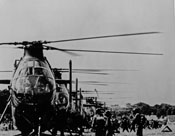
CH-21 helicopters loading troops in Vietnam
U.S. Army Aviation Museum Volunteer Archivists Collection [va058857]
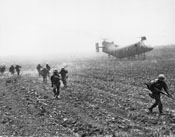
A CH-21 helicopter off-loading troops near An Binh, Vietnam. Photographer: D. Durall
U.S. Army Aviation Museum Volunteer Archivists Collection [va058863]
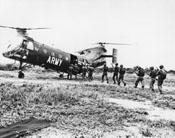
South Vietnamese troops boarding CH-21 helicopter (56-2049)
U.S. Army Aviation Museum Volunteer Archivists Collection [va058867]
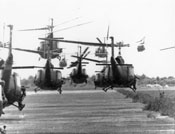
Several UH-1 helicopters lifting off of runway
U.S. Army Aviation Museum Volunteer Archivists Collection [va059094]
Bibliography
- The Brigade: A History - Organization and Employment in the US Army, by John J. McGrath (251 pages)
- OH0417, Anthony LaRusso Collection, The Vietnam Center and Sam Johnson Vietnam Archive, Texas Tech University.
- VA058394, U.S. Army Aviation Museum Volunteer Archivists Collection, The Vietnam Center and Sam Johnson Vietnam Archive, Texas Tech University.
- VA058495, U.S. Army Aviation Museum Volunteer Archivists Collection, The Vietnam Center and Sam Johnson Vietnam Archive, Texas Tech University.
- VA058767, U.S. Army Aviation Museum Volunteer Archivists Collection, The Vietnam Center and Sam Johnson Vietnam Archive, Texas Tech University.
- VA058857, U.S. Army Aviation Museum Volunteer Archivists Collection, The Vietnam Center and Sam Johnson Vietnam Archive, Texas Tech University.
- VA058863, U.S. Army Aviation Museum Volunteer Archivists Collection, The Vietnam Center and Sam Johnson Vietnam Archive, Texas Tech University.
- VA058867, U.S. Army Aviation Museum Volunteer Archivists Collection, The Vietnam Center and Sam Johnson Vietnam Archive, Texas Tech University.
- VA059094, U.S. Army Aviation Museum Volunteer Archivists Collection, The Vietnam Center and Sam Johnson Vietnam Archive, Texas Tech University.
Vietnam Center & Sam Johnson Vietnam Archive
-
Address
Texas Tech University, Box 41041, Lubbock, TX 79409 -
Phone
(806)742-9010 -
Email
vnca@ttu.edu

